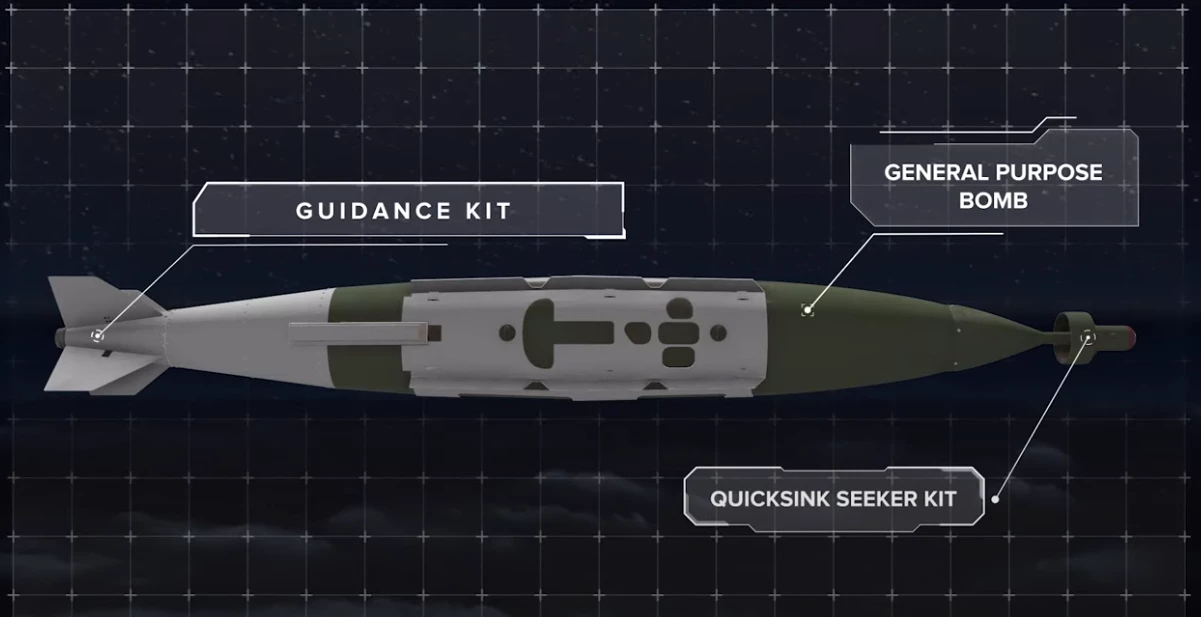The US Air Force has released video of a ship being ripped in half to demonstrate its new Quicksink weapon, which turns an inexpensive dumb bomb into a precision anti-ship missile – and which lives up to its name in spectacular fashion.
Modern weapon systems are amazingly effective, with the ability for a single small warhead to take out a small target that one time would have required a carpet bombing raid or a heavy artillery barrage. Unfortunately, they're also expensive and with the current geopolitical situation suggesting a return to large-scale peer-to-near-peer conflicts, cheaper alternatives that are easier to stockpile have become more attractive.
One example of this is anti-ship weapons. The go-to weapon for this is a torpedo like the US Type 46 torpedo that can deliver 96.8 lb (43.9 kg) of high-explosive PBXN-103 to the target and destroy it by exploding under its keel, breaking the ship's back.
Unfortunately, there are a couple of problems. For one thing, the type 46 costs US$1.2 million per shot. For another, firing one gives away the presence of the attacking submarine. Then there's the fact that even the fastest submarine has a limited ability to intercept targets over a large area.
With the US and its allies facing the problem of keeping the peace in the huge Indo-Pacific region, the ideal solution would be a weapon that can be deployed quickly over long distances and doesn't cost an arm and a leg. That means an anti-ship weapon that can be delivered by the US Air Force.
Being developed by the Air Force Research Laboratory Munitions Directorate at Eglin Air Force Base, Florida, Quicksink is designed to be carried by both fighter planes and bombers. It's essentially a variant of the JDAM system that turns dumb iron bombs into smart munitions by providing a kit that straps onto the bomb to give it airfoils and a guidance system. Quicksink is similar to a variant for delivering sea mines to precise locations except that this one has a laser sensor that straps to the bomb's nose that allows it to zero in on surface vessels that are either stationary or moving.

Using a modular, open-architecture design based on existing technology, Quicksink is able to deliver the lethality of a torpedo at a cost of only US$300,000 per round. Using a stealth fighter or bomber to deliver it as a standoff weapon, it can strike more targets over a greater range than any submarine can.
One drawback that some have pointed out is that as a glide bomb, Quicksink has a flight range of only 40 nm (46 miles, 74 km) and that this makes the attacking aircraft vulnerable to anti-aircraft defenses. However, Quicksink is designed to be dropped from stealthy aircraft flying at high speed and altitude. More importantly, its intended targets are unaccompanied ships that may be carrying contraband or are acting as disguised missile platforms that will not have the defenses of a warship.
During July's RIMPAC SINKEX in the Gulf of Mexico, a B-1 bomber sank the junked MV Monarch Countess with a Quicksink munition, bringing us the remarkable footage above. This is not the first time Quicksink has been demonstrated, but the exercise saw it being tested against other anti-ship weapons and in collaboration with participants from Australia, Malaysia, the Netherlands, the Republic of Korea, and the US Air Force, Army and Navy.
"The development of this technology helps deliver technological superiority to ensure the United States can defend our interests, maintain freedom of action, and seize the initiative over large maritime areas," said Colonel Matthew Caspers, Air Force Research Laboratory, Munitions Directorate Director.
Source: AFRL







